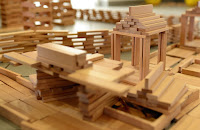If you work within the Early Years sector then I'm sure you have heard of the 'Reggio Emilia Approach' which is a child centred philosophy based on the image of the child.
It was developed in Italy after World War II by Loris Malaguzzi, an educator, psychologist and consultant to the Italian Ministry of Education.
Loris Malaguzzi believed that children show thinking, expression and understanding through a variety of medias (100 Languages of Children). Children will bring their own ideas and theories to the table in which educators should work collaboratively with them, researching together to co-construct learning.
The Reggio Emilia Approach values the child as strong, capable and encourages them to explore their world and express themselves through a variety of languages.
So how can we, as educators, support the 100 Languages of Children?....
MAKE THINKING VISIBLE by documenting the process of creativity. Include photos, conversations, mark making and video to capture thinking and learning.
OFFER OPEN-ENDED RESOURCES to provoke exploration, imagination and creativity. This includes man-made, natural and recycled materials.
FACILITATE PROJECTS that arise form interaction with classroom resources, daily life, child's interests and explorations of identity.
ORGANISE RESOURCES in a systematic way. Label baskets and boxes so that children can clearly see what is available to choose from. Create spaces for children to store and revisit ongoing projects.
DESIGN AN ENVIRONMENT that is warm, welcoming and harmonious. Clear visual clutter, use natural colours and mirrors to reflect light. This enables children to see themselves in the creative process.
PROVIDE HIGH QUALITY MATERIALS for drawing, painting and modelling. Include various mark making tools, colours and textures to encourage detailed creations.





Comments
Post a Comment